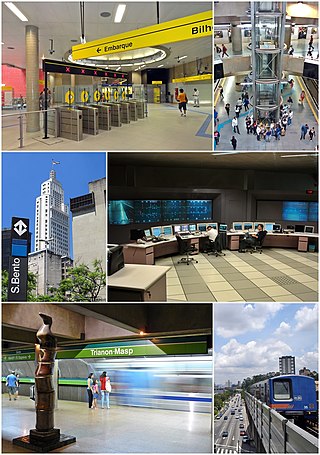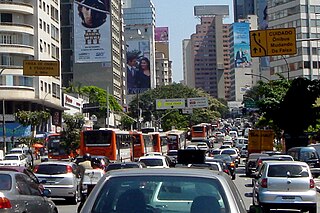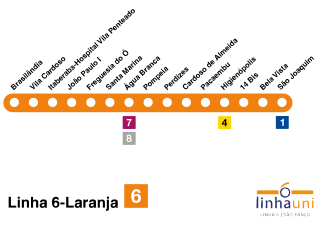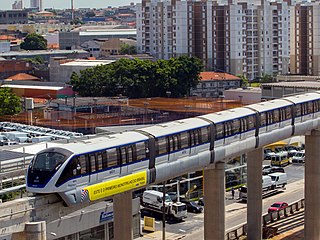
The São Paulo Metro, commonly called the Metrô, is a rapid transit system that forms part of the urban railways that serves the city of São Paulo, alongside the São Paulo Metropolitan Trains Company (CPTM), both forming the largest metropolitan rail transport network of Latin America. The six lines in the metro system operate on 104.4 kilometres (64.9 mi) of route, serving 89 stations. The metro system carries about 4,200,000 passengers a day.

The Companhia Paulista de Trens Metropolitanos (CPTM) is a rapid transit and commuter rail company owned by the São Paulo State Department for Metropolitan Transports. It was created on 28 May 1992, from several railroads that already existed in Greater São Paulo, Brazil.

Transport in São Paulo plays a key role in the daily lives of the people of São Paulo and offers various methods of public transport that are offered in the city, including a complex bus system run by SPTrans, and various subway and railway lines. A contactless smartcard is used to pay fares for the buses, subway, and railway systems. São Paulo also has three airports.

Scomi Rail, formerly MTrans and Monorail Malaysia, was a Malaysian rail system manufacturer specializing in monorails. A subsidiary of Scomi Group, the company was one of the world's three leading providers of monorail systems, and one of only four globally recognized integrated monorail system providers, meaning that apart from manufacturing rolling stock, it also provided equipment like communication systems, electro-mechanical systems and services such as system integration and project management.

Line 2 (Green) (Portuguese: Linha 2–Verde) is one of the six lines that make up the São Paulo Metro, and one of the thirteen lines that make up the Metropolitan Rail Transportation Network. It currently runs between the Vila Madalena and Vila Prudente stations. The line is also called, and was originally known as, the Paulista Line, because it goes along much of the Avenida Paulista, one of the leading financial centers in São Paulo. Despite being the second line to be planned, it was the third to be built—the second line built was actually Line 3 (Red). This line connects the West and South-East regions.

Line 6 (Orange) (Portuguese: Linha 6–Laranja) is an under construction line of the São Paulo Metro. The first section will be 15.9-kilometre (9.9 mi) long, with 15 stations, and will link the São Joaquim metro station (Line 1 (Blue) to the district of Brasilândia. The branch is known as the "Colleges line" as it will serve many of them along its route (FAAP, PUC-SP and Mackenzie University).

Line 15 (Silver) (Portuguese: Linha 15–Prata) is one of the six lines that make up the São Paulo Metro and one of the thirteen lines that make up the Metropolitan Rail Transportation Network. It is South America's first mass-transit monorail and is the first system in the world to use the Bombardier Innovia Monorail 300. When completed it will be the largest and highest capacity monorail system in the Americas and second worldwide only to the Chongqing Monorail. The first section, from Vila Prudente to Oratório, opened on 30 August 2014, initially running 10 AM–3 PM on weekends only. As of 26 October 2016, the line is operational from 4:40 AM–12 AM. The line has a free connection to Line 2-Green on Vila Prudente station and future connection to CPTM Line 10-Turquoise on Ipiranga station.

Line 17 (Gold) (Portuguese: Linha 17–Ouro) is an under construction monorail project for the São Paulo Metro. The line will have 14 stations, beginning at the São Paulo-Morumbi station and ending at the Jabaquara station, with a branch to Congonhas station, connected to the São Paulo/Congonhas Airport. It will have integration with Line 1-Blue, Line 4-Yellow, and Line 5-Lilac as well as CPTM Line 9-Emerald. The line was originally one of the transportation projects supporting the 2014 FIFA World Cup. However, delays and contract disputes have pushed the completion date from the original 2013 full opening date to 2026. Once completed, the line will be the first in the system to have a branch.

The São Mateus–Jabaquara metropolitan corridor (Portuguese: Corredor Metropolitano São Mateus-Jabaquara), also called ABD Corridor (Corredor ABD) is a bus rapid transit line in Brazil, linking the city of São Paulo to three neighboring cities, Diadema, São Bernardo do Campo and Santo André, as well as (indirectly) Mauá. Operations started in 1988. Its other name references one letter per city (A for Santo André, B for São Bernardo do Campo, and D for Diadema), the same way the ABC region in Greater São Paulo is named.

Innovia Monorail is a fully automated and driverless monorail system currently manufactured and marketed by Alstom as part of its Innovia series of fully automated transportation systems. Its straddle-beam design is based on the ALWEG monorail, which was first developed in the 1950s and later popularized by Disney at their theme parks.
Morumbi is a future monorail station, which will be operated by ViaMobilidade. Placed in the district of Santo Amaro in São Paulo, it will connect with homonymous station of Line 9-Emerald.

Chucri Zaidan will be a monorail station of Line 17-Gold of ViaMobilidade, which is currently under construction, and will connect Line 9-Emerald to Congonhas Airport.

Brooklin Paulista will be a monorail station of Line 17-Gold of ViaMobilidade, which is currently under construction, and will connect Line 9-Emerald to Congonhas Airport.

Jardim Colonial is a monorail station of São Paulo Metro. It serves Line 15-Silver, which connects the nearby neighbourhood to the Metro Line 2-Green in Vila Prudente. It's located in Avenida Ragueb Chohfi, 1400.

Ipiranga is a train station on CPTM Line 10-Turquoise, located in the city of São Paulo. The station is located on the west side of Vila Prudente district.
Prefeito Saladino is a train station on CPTM Line 10-Turquoise, located in the city of Santo André.
Service 710 is a commuter rail service operated by Companhia Paulista de Trens Metropolitanos in the Greater São Paulo, Brazil. It is a route that unifies both lines 7-Ruby and 10-Turquoise of the metropolitan rail network of the state of São Paulo. It offers a service from Jundiaí to Rio Grande da Serra stations and from Francisco Morato to Mauá during peak hours. Outside the Francisco Morato-Mauá loop, commuter will have to leave the train and wait for the next one to proceed, with a 12 minutes headway.
BRT ABC is a future bus rapid transit (BRT) system for the southwest Greater São Paulo as a successor of the São Paulo Metro Line 18-Bronze monorail project, cancelled in 2019 by governor João Doria.

The São Paulo Metro M stock is a class of trains built by Bombardier between 2011 and 2014 to operate on Line 15-Silver, opened in 2014. This is the first monorail class of trains of the state of São Paulo.














